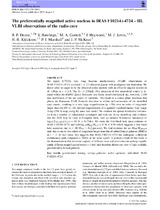| dc.contributor.author | Deane, Roger P. | |
| dc.contributor.author | Rawlings, S. | |
| dc.contributor.author | Jarvis, Matt | |
| dc.contributor.author | Garrett, M. A. | |
| dc.contributor.author | Heywood, Ian | |
| dc.contributor.author | Klöckner, H. R. | |
| dc.contributor.author | Marshall, P. J. | |
| dc.contributor.author | McKean, J. P. | |
| dc.date.accessioned | 2017-07-14T08:05:19Z | |
| dc.date.available | 2017-07-14T08:05:19Z | |
| dc.date.issued | 2013 | |
| dc.identifier.citation | Deane, R. et al. (2013). The preferentially magnified active nucleus in IRAS F10214+4724 - III. VLBI observations of the radio core. Monthly Notices of the Royal Astronomical Society, 434: 3322–3336 | en_US |
| dc.identifier.issn | 0035-8711 | |
| dc.identifier.uri | http://hdl.handle.net/10566/3079 | |
| dc.description.abstract | We report 1.7GHz very long baseline interferometry (VLBI) observations of IRAS F10214+4724, a lensed z = 2.3 obscured quasar with prodigious star formation. We detect what we argue to be the obscured active nucleus with an effective angular resolution of <50pc at z = 2.3. The S1.7 =210µJy (9σ) detection of this unresolved source is located within the Hubble Space Telescope rest-frame ultraviolet/optical arc, however, 100 mas northwards of the arc centre of curvature. This leads to a source-plane inversion that places the European VLBI Network detection to within milliarcseconds of the modelled cusp caustic, resulting in a very large magnification (μ ∼70), over an order of magnitude larger than the CO (1→0) derived magnification of a spatially resolved Jansky Very Large Array (JVLA) map, using the same lens model. We estimate the quasar bolometric luminosity from a number of independent techniques and with our X-ray modelling find evidence that the AGN may be close to Compton thick, with an intrinsic bolometric luminosity of log10( Lbol, QSO /L ) = 11.34 ± 0.27dex. We make the first black hole mass estimate of IRAS F10214+4724 and find log10(MBH/M ) = 8.36 ± 0.56 which suggests a low black hole accretion rate (λ = ˙M/ ˙ MEdd ∼3±7 2 percent). We find evidence for an MBH/Mspheroid ratio that is one to two orders of magnitude larger than that of submillimetre galaxies (SMGs) at z ∼ 2. At face value, this suggests that IRAS F10214+4724 has undergone a different evolutionary path compared to SMGs at the same epoch. A primary result of this work is the demonstration that emission regions of different sizes and positions can undergo significantly different magnification boosts (>1dex) and therefore distort our view of high-redshift, gravitationally lensed galaxies. | en_US |
| dc.language.iso | en | en_US |
| dc.publisher | Oxford University Press | en_US |
| dc.rights | Publisher retains copyright. Authors may archive the published version in their institutional repository. | |
| dc.source.uri | http://dx.doi.org/10.1093/mnras/stt1241 | |
| dc.subject | Gravitational lensing | en_US |
| dc.subject | Strong galaxies | en_US |
| dc.subject | Active galaxies | en_US |
| dc.subject | Individual | en_US |
| dc.subject | IRAS | en_US |
| dc.title | The preferentially magnified active nucleus in IRAS F10214+4724 - III. VLBI observations of the radio core | en_US |
| dc.type | Article | en_US |
| dc.description.accreditation | Department of HE and Training approved list | |

